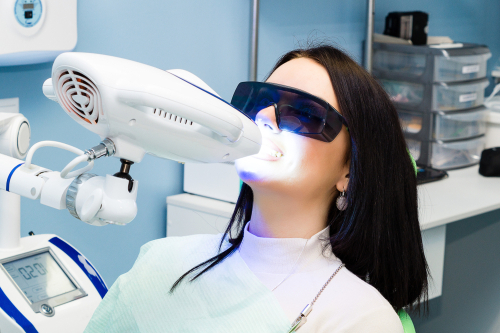Many people aspire to have a bright, white smile. However, over time, teeth can become stained or discolored due to factors like aging, genetics, and lifestyle choices. A common cosmetic dental procedure called teeth whitening can help give your smile a brighter, more youthful appearance.

Techniques for Whitening Teeth
The two primary methods for teeth whitening are in-office procedures and at-home procedures. A dental professional administers in-office treatments, which typically use more potent bleaching agents than those found in over-the-counter products. Over-the-counter products, such as whitening toothpaste, strips, or gels, can be used for at-home treatments.
Whitening teeth in-office
For those who want quick and efficient results, in-office teeth whitening is a popular choice. During an in-office procedure, a dentist coats the teeth with a highly concentrated whitening agent before activating it with a unique light. The entire process typically lasts an hour, and the results are visible right away. However, office visits can be costly and insurance may not always cover them.
Whitening Teeth at Home
For many people, teeth whitening done at home is a more practical and affordable option. Such over-the-counter goods as whitening toothpaste, strips, and gels are widely available. Since the bleaching agent in these products is typically used in lower concentrations than in offices, it may take longer to see results. However, home treatments are often more affordable than office treatments and can be completed on your own schedule.
Effective Teeth Whitening Advice
Whatever method you decide to use, here are some pointers to remember to get the best outcomes:
1. Carefully follow the instructions: Whether using an over-the-counter product or an in-office treatment, it’s critical to do so to prevent harming your teeth or gums.
2. Have patience: Whitening your teeth requires ongoing maintenance. Depending on how severe your stains or discoloration are, it might take several sessions or even a few weeks to see the desired results.
3. Steer clear of certain foods and beverages: Red wine, soda, coffee, tea, and other substances can stain your teeth. Maintaining your results after teeth whitening can be made easier by avoiding or limiting these foods and beverages.
4. Practice good oral hygiene: Regular tooth brushing and flossing can help stop new stains from developing on your teeth.
Alternatives to Teeth Whitening
There are various methods for whitening teeth, such as:
1. Toothpaste for teeth whitening: Toothpaste for teeth whitening includes unique abrasives and chemicals that aid in removing surface stains from teeth.
2. Whitening strips: Whitening strips are thin, flexible strips covered in a whitening gel made of peroxide. They are placed right on the teeth and are left there for a predetermined period of time.
3. Whitening gels are applied to the teeth with a tiny brush or tray. Compared to whitening toothpaste or strips, they typically have a higher peroxide content.
4. In-office procedures: In-office procedures are completed by a dental expert and frequently make use of more potent bleaching agents than those present in over-the-counter goods.
5. Custom trays: Made by a dentist, custom trays are crafted to precisely fit your teeth. They contain a whitening gel and must be worn for a set period of time each day.
Conclusion
A common cosmetic dental procedure called teeth whitening can help give your smile a brighter, more youthful appearance. The technique or option that best suits your needs and budget should be chosen from the many that are offered. Whether you opt for an in-office or at-home treatment, it’s crucial to pay close attention to the directions and be patient throughout the process. Additionally, practicing good oral hygiene and abstaining from particular foods and beverages can help you keep your results and preserve your smile’s health and brightness.